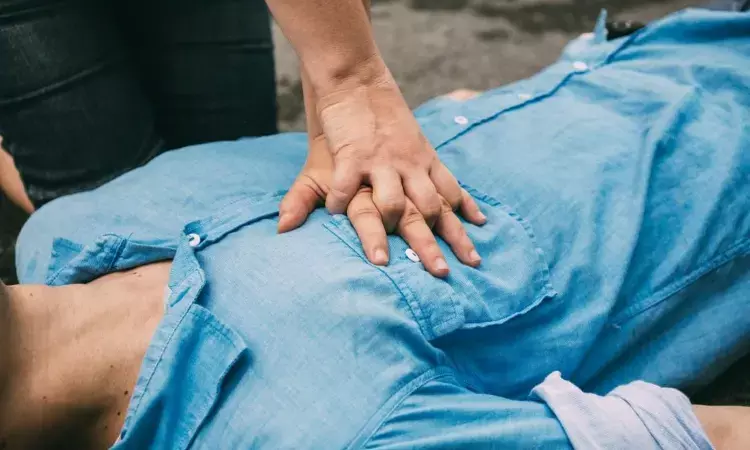- Home
- Medical news & Guidelines
- Anesthesiology
- Cardiology and CTVS
- Critical Care
- Dentistry
- Dermatology
- Diabetes and Endocrinology
- ENT
- Gastroenterology
- Medicine
- Nephrology
- Neurology
- Obstretics-Gynaecology
- Oncology
- Ophthalmology
- Orthopaedics
- Pediatrics-Neonatology
- Psychiatry
- Pulmonology
- Radiology
- Surgery
- Urology
- Laboratory Medicine
- Diet
- Nursing
- Paramedical
- Physiotherapy
- Health news
- Fact Check
- Bone Health Fact Check
- Brain Health Fact Check
- Cancer Related Fact Check
- Child Care Fact Check
- Dental and oral health fact check
- Diabetes and metabolic health fact check
- Diet and Nutrition Fact Check
- Eye and ENT Care Fact Check
- Fitness fact check
- Gut health fact check
- Heart health fact check
- Kidney health fact check
- Medical education fact check
- Men's health fact check
- Respiratory fact check
- Skin and hair care fact check
- Vaccine and Immunization fact check
- Women's health fact check
- AYUSH
- State News
- Andaman and Nicobar Islands
- Andhra Pradesh
- Arunachal Pradesh
- Assam
- Bihar
- Chandigarh
- Chattisgarh
- Dadra and Nagar Haveli
- Daman and Diu
- Delhi
- Goa
- Gujarat
- Haryana
- Himachal Pradesh
- Jammu & Kashmir
- Jharkhand
- Karnataka
- Kerala
- Ladakh
- Lakshadweep
- Madhya Pradesh
- Maharashtra
- Manipur
- Meghalaya
- Mizoram
- Nagaland
- Odisha
- Puducherry
- Punjab
- Rajasthan
- Sikkim
- Tamil Nadu
- Telangana
- Tripura
- Uttar Pradesh
- Uttrakhand
- West Bengal
- Medical Education
- Industry
Head-up CPR bundle improves neurologically favorable survival in cardiac arrest: Study

USA: CPR using head-up/torso-up (HTup) positions is tied to markedly improved odds of neurologically-favorable out-of-hospital cardiac arrest (OHCA) survival, reveals a recent study published in the journal Critical Care Medicine.
In pilot clinical studies of OHCA, the modified physiological approach to CPR through CPR using HTup positions and adjuncts to lower ICP (and enhance venous return) facilitates neuro-intact survival pre-clinically and markedly improves resuscitation rates. Paul Pepe, University of Texas Health Sciences Center at Houston, Dallas, TX, and colleagues aimed to confirm improved neuro-intact patient survival (SNI) using this method.
For this purpose, the researchers obtained prospectively collected data from a national AHUP registry in which 6 participating EMS agencies routinely tracked SNI for OHCA as well as T911-CPR, the elapsed time from 9-1-1 call to initiation of an automated HTup CPR device (AHUP) combined with manual (or automated) active compression-decompression and impedance threshold devices (all FDA-cleared).
AHUP steadily boosts the head/torso over several minutes (occiput reaching 22 cm). Conventional CPR (C-CPR) controls were derived from 3 large-scale published OHCA trials for rigorous comparison. These trials involved 5,330 patients from high-performance EMS systems including those that closely monitored, recorded, and reported the quality of CPR.
Imbalances in characteristics (age; sex; bystander-witnessed; bystander CPR; shockable rhythm; T911-CPR (C-CPR or AHUP initiation) were accounted for by multivariate and propensity score analyses. Each AHUP patient (n=227) was matched with up to 4 C-CPR patients (n=930) in propensity analysis. SNI was defined as achieving mRS≤3 (or CPC 1 or 2 in one study).
Based on the study, the researchers found the following:
- Regardless of presenting cardiac rhythm, early initiation (T 911-CP < 20 min) of the AHUP bundle was associated with profoundly higher rates of SNIvs. current published findings.
- Even compared to high-performance/highly-monitored EMS systems and stratified by T911-CPR, SNI< differences with the AHUP resuscitation bundle became increasingly more significant than C-CPR with shorter T911-CPR (eg, SNI was nearly 3-fold higher with T911-CPR< 13 mins [OR 2.68] and nearly 5-fold higher [OR 4.74 if < 8 mins).
"The HTup CPR resuscitation bundle is tied to markedly improved odds s of neurologically-favorable OHCA survival versus C-CPR even when comparing well-matched controls with closely-monitored CPR performance," wrote the authors. "In addition, shorter times to bundle initiation further augment the odds of neuro-intact survival."
Reference:
Pepe, Paul1; Moore, Johanna2; Labarère, José3; Lick, Charles4; Scheppke, Kenneth5; Antevy, Peter6; Coyle, Charles7; Quinn, Ryan8; Holley, Joseph9; Hutchison, Edwin (Mack)10; Adams, Paul11; Crowe, Remle12; Duval, Sue2; Debaty, Guillaume3; Lurie, Keith13 2: CLINICAL CONFIRMATION OF PROFOUND IMPROVEMENTS IN NEURO-INTACT SURVIVAL USING THE HEAD-UP CPR BUNDLE, Critical Care Medicine: January 2022 - Volume 50 - Issue 1 - p 1 doi: 10.1097/01.ccm.0000806476.05930.03
Dr Kamal Kant Kohli-MBBS, DTCD- a chest specialist with more than 30 years of practice and a flair for writing clinical articles, Dr Kamal Kant Kohli joined Medical Dialogues as a Chief Editor of Medical News. Besides writing articles, as an editor, he proofreads and verifies all the medical content published on Medical Dialogues including those coming from journals, studies,medical conferences,guidelines etc. Email: drkohli@medicaldialogues.in. Contact no. 011-43720751


